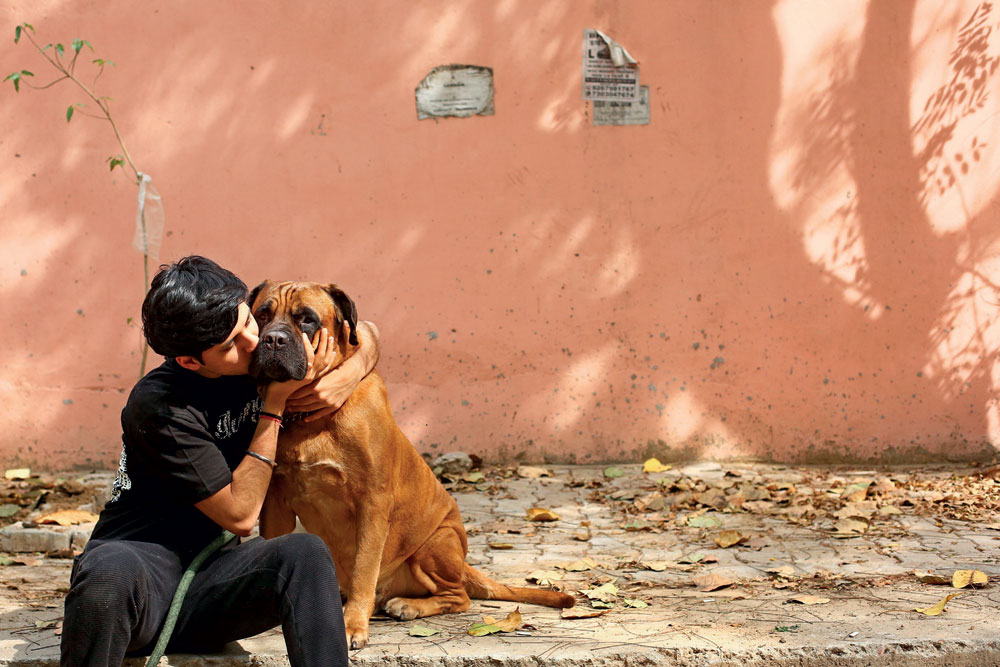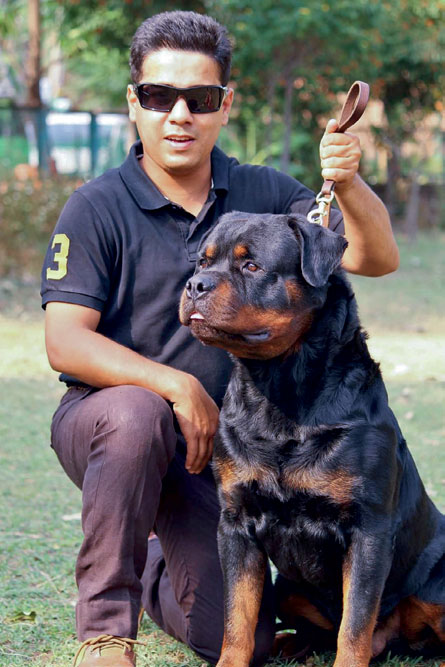Wag the Big Dog
When flaunting the ferocious breeds becomes a status symbol
 Soumava Haldar
Soumava Haldar
 Soumava Haldar
|
29 Mar, 2024
Soumava Haldar
|
29 Mar, 2024
/wp-content/uploads/2024/03/Bigdog1.jpg)
(Illustration: Saurabh Singh)
AT A DOG RESCUE SHELTER in Noida, Simba, an 18-month-old American Bully, sits with longing eyes inside the small barricaded space, oblivious to the ruckus that his sister Coco, a Pitbull, is creating at the arrival of a group of strangers. A caretaker employed at the shelter to look after the two dogs explains Coco’s excitement as a reaction to seeing new faces in the shelter after a long time. Simba gingerly lifts himself and comes to the front of the barricade to get a better look at us. A little later, after having seemingly satisfied her curiosity, Coco follows her brother’s lead to the front of the barricade, now competing with him to get petted by the new strangers.
“I have had Coco and Simba for close to two years now. Simba is an Alpha. He doesn’t like any other canines around him. But he has taken a special liking to Coco,” says Nikhil Kukreja, the owner of the pet shelter, Peekapoo Foundation, while walking in. “These days, it is impossible to keep big dogs in residential societies. I had to move my own dogs to my shelter as people often complained about them in my society. The ban [by the government] will just prompt people now to leave their dogs out in the streets. It will be a repeat of the post-Covid situation again when hundreds of dogs were abandoned. At least 10-15 per cent of those dogs were from the ‘big breeds’,” he says. The ban Kukreja is talking about was implemented by the Centre on March 13, as it brought in a host of regulations restricting the import, sale, and breeding of 23 ‘ferocious’ dog breeds which are considered a ‘threat to human life’. The Uttar Pradesh government soon after followed the Centre’s lead and on March 27 asked all its chief veterinary officers to implement the ban.
The move, though well-meaning, has set forth concern among owners of such a ‘big breed’ of dogs, their prime anxiety centred on whether they would be required to give up their furry companions.
Out for walks, or just playing around in parks, Delhi NCR has arguably more dogs per square metre than any other city in the country. Rottweilers, Boxers, Saint Bernards, Great Danes, Dobermans, Pitbull Terriers are all par for the course in the city. So, why are big dogs the new status symbol? Two words, say dog experts: vanity and a need for flaunting.
“People want to flaunt their uniqueness, especially in Delhi NCR. It is about getting appreciation here, be it for their cars, their clothes or the kind of dogs they own. Certain dogs have certain behavioural traits. A Shih Tzu, for example, is an easy-to-handle breed. But others, like Rottweilers or Dogo Argentino, were bred for very specific purposes before people started domesticating them, and therefore need very specific care,” says Shikhar Joseph, a canine expert and dog trainer who owns an agency based out of South Delhi’s Safdarjung Enclave that conducts checks on families who want to adopt dogs, and audits pet shops and breeders that supply such puppies. According to him, there is a definite lack of knowledge among people about various dog breeds. “Dogs are often sold as commodities in the market; good-looking puppies get sold first. Very often, people buy these puppies and then abandon them when they get older. They don’t expect a puppy to grow so big and become so difficult to handle,” Joseph adds.
These poorly thought-out decisions to bring dogs unsuitable to cramped city living have led to grave consequences. Several cases of injury or death due to dog bites have surfaced across the country in the past few months. The most recent one in Delhi, according to a report, was in February, when a toddler was hospitalised for 17 days after she was bitten by a Pitbull. In another incident in March, a 10-year-old was critically injured in Ghaziabad after a Pitbull attacked her. In July 2022, an 82-year-old retired teacher was mauled to death by her son’s pet Pitbull in the Qaiserbagh area of Lucknow.

In a report tabled in Rajya Sabha, the Ministry of Health and Family Welfare last year stated that incidents of dog bites in India have seen a 26.5 per cent year-on-year increase, from 2.18 million incidents in 2022 to 2.75 million incidents in 2023. According to the ministry’s response, Kerala witnessed the highest percentage increase in cases of dog bites. The southern state saw a 1,486 per cent rise to 63,458 incidents in 2023 as compared to 4,000 incidents recorded in 2022. The national capital recorded a total of 16,133 incidents in 2023, as compared to 6,634 incidents in 2022. These numbers, however, did not specify how many of these injuries were caused by dogs on the list of 23 banned breeds, as many have pointed out. The current ban, animal welfare activists believe, therefore, is misdirected.
“Ban the breeders, not the breeds,” exhorts Vandana Menon, a resident of South Delhi’s Nizamuddin East colony, who is actively involved with animal welfare projects. “Largescale illegal breeding of such big breed dogs has taken off in the last five-seven years. Dogs are bred as per demand, almost like ‘the flavour of the month’. It is easy money as each puppy can fetch close to `1 lakh,” Menon says.
“We got a Mastiff because they are protective, loyal and easy-going. It is the lack of socialisation, upbringing and training that makes a dog dangerous,” says Shaurya Palit, dog owner
The easy availability of crossbred puppies also means that anyone with enough liquid cash can now become a dog owner. “So, it shouldn’t be a surprise today if someone living even in an unregularised colony of Delhi is spotted walking a Pitbull or a Rottweiler. And mind you, these dogs are not native to India, therefore people who adopt or buy them have very little clue about how to handle them. Some may just be adopted to take part in illegal dog fights that take place in Punjab and Haryana,” Menon adds. Concerns related to illegal dogfighting rings have been raised in other quarters as well. PETA India, in its response to the ban, had said, “We applaud the Central government for taking this step to safeguard these vulnerable dog breeds, who are commonly exploited by criminal elements of society for illegal dogfighting, as well as children and elderly citizens who are wounded and even killed by specific types of dogs who are manipulated and trained to consider other living beings as ‘prey’.”
Tandrali Kuli, a member of Delhi-based animal rescue NGO, Friendicoes, has a different take. She says that in their experience, most of the banned large breed dogs are found amongst sections of society who are “unaware and ignorant”.
“People here own these dogs mostly to breed them or to portray a macho image. You will find them in low-income colonies in and around Delhi NCR which are buzzing with ‘backyard breeders’ always looking to make a quick buck. Young men in such colonies especially like to keep big dogs to project a sense of power,” Kuli, who has three Rottweilers at home, says. Every dog, even the ones which are known to be extremely human-friendly, can become aggressive if not exercised, trained and kept in healthy living conditions, she says. Dog abandonment is a persistent issue in the capital, she adds, even as her phone buzzes with a notification about the need to rescue a pregnant Pitbull who had been found abandoned at South Delhi’s Sangam Vihar.
Canine trainers such as Tejshree Savara agree with Kuli. “All dogs, regardless of their breed, should undergo training, but more importantly, their owners need education and guidance about their care. Unwanted behaviour from dogs can largely be avoided when the owners take the correct care measures,” says Savara, who is a trainer and the founder of Pack-9, a South Delhi-based dog boarding, training and enrichment centre.

Meghna Uniyal, the director of Humane Foundation for People and Animals, a Pune-registered non-government company, thinks the kind of dog one prefers to have is a personal choice, not a moral one. A lawyer by profession, Uniyal says that in India dogs are considered to be the ‘property’ of the owner by the law—which makes the owner culpable for the dog’s actions and behaviour. “Dogs are bred and chosen for very specific purposes and needs. In India, having a big dog is like buying expensive sports/foreign cars with very low ground clearance. People know our country has bad roads, ill-suited for such cars. They still want to have the car.”
The ban on ‘ferocious’ dog breeds, Uniyal said, was constitutionally unlawful and could not be enforced on the public. “The Karnataka and Calcutta High Courts have already stayed the ban. The Delhi High Court has asked the government to submit its report that led to the ban. The ban will become a harassment for dog owners and breeders.”
“My grandfather brought the first couple of Rottweilers back in 1995. We have been breeding them ever since. People like bigger dogs. We, for our part, evaluate buyers; we study the family that wants to own them. We ensure whether the family will be able to look after its needs,” says Sikandar Singh, Rottweiler breeding expert
A big uptick in people getting dogs ill-suited for their living spaces was during Covid. But that was just part of a trend that had started years before the pandemic. While more commonplace breeds like Cocker Spaniels, Labradors and Beagles remained popular, demand for exotic dogs—including Pitbulls, Rottweilers and Mastiffs—has seen a silent growth over the last 10 years.
Breeders of such big breed dogs, however, had their own point of view to put forth.
Sikandar Singh, a Rottweiler breeding expert from Haryana, says that his family was one of the first to have introduced the breed in India. “My grandfather brought the first couple of Rottweilers back in 1995. We have been breeding them ever since. Initially, we used to give Rottweiler puppies only to friends and family. But now things have changed. People like bigger dogs. We, for our part, evaluate buyers; we study the family that wants to own them. We ensure whether the dog will have enough space to exercise and whether the family will be able to look after its needs properly. People need to understand the temperament of a dog,” Singh says.
With a ban in place, what happens to the 18 Rottweiler puppies he has on his farm? “Of course, we will gladly keep them. They are like my family,” he says. According to the new regulations, owners who already have ‘dangerous breeds’ will need to sterilise them.
Dwarka resident Shaurya Palit, an investment banker and the proud parent of an English Mastiff, prefers referring to his fur baby as a ‘gentle giant’. “We got Simba from a breeder in Ambala. He has been with us for more than 8 years now. We chose to get a Mastiff because they are protective, loyal and easygoing with kids. Some breeds have been deemed ferocious by the government, but I strongly believe that it is the lack of socialisation, upbringing and training that makes a dog dangerous. The only time Simba gets aggressive is when he deems a threat to the family. He has been trained that way,” he says. Palit, 21, adds that before Simba his parents had a Saint Bernard that they gave up for adoption after he was born.
Sadist and psychotic tendencies are not found in animals. As animal rights activists like Menon point out, our populace had adapted to certain pedigreed breeds. We had understood their needs and their psychology. And then owing to a frenzy of illegal breeders, dogs from the hound family were introduced. Sometimes as a status symbol, sometimes as a means to fit in, and sometimes just as a show of pseudo-machismo, these big dogs were lapped up by people. The ban may not fix nor address the problem of bad owners. The issue remains—as long as humans disregard the requirements of other species around them, even ‘man’s best friend’ could turn against him from time to time.

/wp-content/uploads/2025/07/Cover_Dalai-Lama.jpg)












More Columns
Trump Restarts Tariff War With the World Open
‘Why Do You Want The Headache of Two Dalai Lamas’ Lhendup G Bhutia
Predicting the Rain Anoop Mahajan